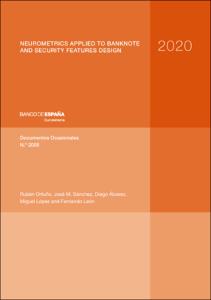Neurometrics applied to banknote and security features design
Autor
Fecha de publicación
24-abr-2020
Descripción física
54 p.
Resumen
El objetivo de este trabajo es presentar una metodología sobre la aplicación del neuroanálisis en el diseño de billetes y elementos de seguridad. Tradicionalmente, la evaluación de la percepción de los billetes se ha basado en respuestas explícitas de las personas, obtenidas a través de cuestionarios y entrevistas. Las medidas implícitas se refieren a métodos y técnicas capaces de capturar los procesos mentales implícitos de las personas. La neurociencia ha demostrado que la consciencia humana no interviene en la mayoría de los procesos cerebrales que regulan las emociones, actitudes, comportamientos y decisiones. Es decir, estos procesos implícitos son funciones cerebrales que se producen automáticamente y sin control consciente.
La metodología sobre el neuroanálisis puede aplicarse al diseño de billetes y elementos de seguridad, y utilizarse como una herramienta de análisis eficaz para evaluar los procesos cognitivos de las personas, como el interés visual, la atención a ciertas áreas del billete, las emociones, la motivación, la carga mental para comprender el diseño y el nivel de estimulación. La metodología del neuroanálisis propuesta ofrece un criterio para tomar decisiones sobre qué diseños de billetes y elementos de seguridad tienen una configuración más adecuada para el público, basada en el seguimiento de procesos conscientes, usando medidas explícitas tradicionales, y procesos inconscientes, usando técnicas neurométricas.
La metodología del neuroanálisis trata variables neurométricas cuantificables obtenidas del público al procesar eventos como el movimiento ocular, la fijación visual, la expresión facial, la variación del ritmo cardíaco, la conductancia de la piel, etc. La aplicación de un estudio de neuroanálisis se lleva a cabo con un grupo de personas representativo de la población para la que se realiza el diseño de un billete o los elementos de seguridad.
En el estudio neurométrico se ofrece a los participantes muestras físicas adecuadamente
preparadas para recoger las diferentes respuestas neurométricas de los participantes, que
luego se procesan para sacar conclusiones.
The aim of this paper is to present a methodology on the application of neuroanalysis to the design of banknotes and security features. Traditionally, evaluation of the perception of banknotes is based on explicit personal responses obtained through questionnaires and interviews. The implicit measures refer to methods and techniques capable of capturing people’s implicit mental processes. Neuroscience has shown that, in most brain processes regulating emotions, attitudes, behaviours and decisions, human consciousness does not intervene. That is to say, these implicit processes are brain functions that occur automatically and without conscious control. The methodology on neuroanalysis can be applied to the design of banknotes and security features, and used as an effective analysis tool to assess people’s cognitive processes, namely: visual interest, attention to certain areas of the banknote, emotions, motivation and the mental load to understand the design and level of stimulation. The proposed neuroanalysis methodology offers a criterion for making decisions about which banknote designs and security features have a more suitable configuration for the public. It is based on the monitoring of conscious processes, using traditional explicit measures, and unconscious processes, using neurometric techniques. The neuroanalysis methodology processes quantifiable neurometric variables obtained from the public when processing events, such as eye movement, sight fixation, facial expression, heart rate variation, skin conductance, etc. A neuroanalysis study is performed with a selected group of people representative of the population for which the design of a banknote or security features is made. In the neurometric study, suitably prepared physical samples are shown to the participants to collect their different neurometric responses, which are then processed to draw conclusions.
The aim of this paper is to present a methodology on the application of neuroanalysis to the design of banknotes and security features. Traditionally, evaluation of the perception of banknotes is based on explicit personal responses obtained through questionnaires and interviews. The implicit measures refer to methods and techniques capable of capturing people’s implicit mental processes. Neuroscience has shown that, in most brain processes regulating emotions, attitudes, behaviours and decisions, human consciousness does not intervene. That is to say, these implicit processes are brain functions that occur automatically and without conscious control. The methodology on neuroanalysis can be applied to the design of banknotes and security features, and used as an effective analysis tool to assess people’s cognitive processes, namely: visual interest, attention to certain areas of the banknote, emotions, motivation and the mental load to understand the design and level of stimulation. The proposed neuroanalysis methodology offers a criterion for making decisions about which banknote designs and security features have a more suitable configuration for the public. It is based on the monitoring of conscious processes, using traditional explicit measures, and unconscious processes, using neurometric techniques. The neuroanalysis methodology processes quantifiable neurometric variables obtained from the public when processing events, such as eye movement, sight fixation, facial expression, heart rate variation, skin conductance, etc. A neuroanalysis study is performed with a selected group of people representative of the population for which the design of a banknote or security features is made. In the neurometric study, suitably prepared physical samples are shown to the participants to collect their different neurometric responses, which are then processed to draw conclusions.
Publicado en
Documentos Ocasionales / Banco de España, 2008
Materias
Neuroscience; Eye tracking; Biometrics; Neurometrics; Banknotes; Neurodesign; Security feature; Perception; Human behaviour; Psicología; Información e incertidumbre; Sistema monetario y financiero
Aparece en las colecciones:












